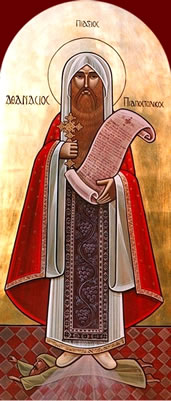Julius I
We know little of the personal life and attributes of Julius. A Roman by birth, he became bishop of Rome a few weeks before the death of Constantine and guided the church of Rome for fifteen years. Sylvester I (314-335) had overseen the Roman church during the extraordinary changes which came with the conversion of Constantine and the legalizing of the church’s status. The physical development of Roman Christianity in the form of increasingly large church buildings, a rapidly growing membership and a more formalized administrational structure continued under Julius’ steady hand. Two basilicas within the city and three in its immediate suburbs were associated with his name, confirming his interest in this aspect of his official duties.
During his episcopacy, however, Rome was dragged into the doctrinal controversies surrounding the relationship of Jesus to the Father, disputes that had shaken the Eastern church. Numerous Eastern bishops, deposed for their disagreements with the opponents of the Christology approved at Nicaea in 325, took refuge at Rome. These included Marcellus of Ancyra and Athanasius of Alexandria. Faced with the decision whether to allow such deposed bishops to commune while in Rome, Julius appropriately brought the question to his local meeting of clergy. When the Eastern bishops failed to defend their actions, the Roman council (341) declared their actions invalid, and eventually Athanasius was reinstated. In the process, Julius would become known to subsequent generations as a strong proponent of Nicene Christology, a reputation that would cause his name to be attached to numerous Christological treatises that were, in fact, composed far from Rome generations after his death.
Julius himself played only an indirect role in the continuing Arianist conflicts. Two letters addressed to him by the (Western) Council of Sardica (343) and another from two Arianist sympathizers (Ursacius and Valens) provide brief glimpses into the final decade of his episcopacy. His choice of burial sites, near the tomb of Callixtus I (218-223) on the Via Aurelia, may indicate his wish to be remembered as a compassionate peacemaker more than as a theologian.
What little we know of Julius’s life and episcopacy comes from the notice in the Liber Pontificalis, based on the earlier entry in the Liberian Catalog; and on the six surviving letters in his correspondence. Originally collected by Pierre Coustant in his Epistulae romanorum pontificum (1721), a complete modern edition and English translation has now been provided by fourthcentury.com’s director, Glen L. Thompson: The Correspondence of Pope Julius I (Library of Early Christianity, Catholic University of America Press, 2015). This volume also contains a complete list of the letters and fragments which over the centuries have been falsely attributed to Julius. Translations of those fragments are available on this site (see the link below). Due to the constraints of the publisher, the complete critical apparatus for the six letters in the edition is also provided here instead.
Resources on Julius I
Complete critical apparatus to accompany The Corrsepondence of Pope Julius I
English translations of the Documents falsely attributed to Julius
English translation of the Liber Pontificalis entry on Julius
English translation of the Liberian Catalog entry on Julius
Jaffe-Kaltenbrunner’s Regesta entry on Julius (1885)
created by GLT and AMJ 2/6/15
No Responses yet
